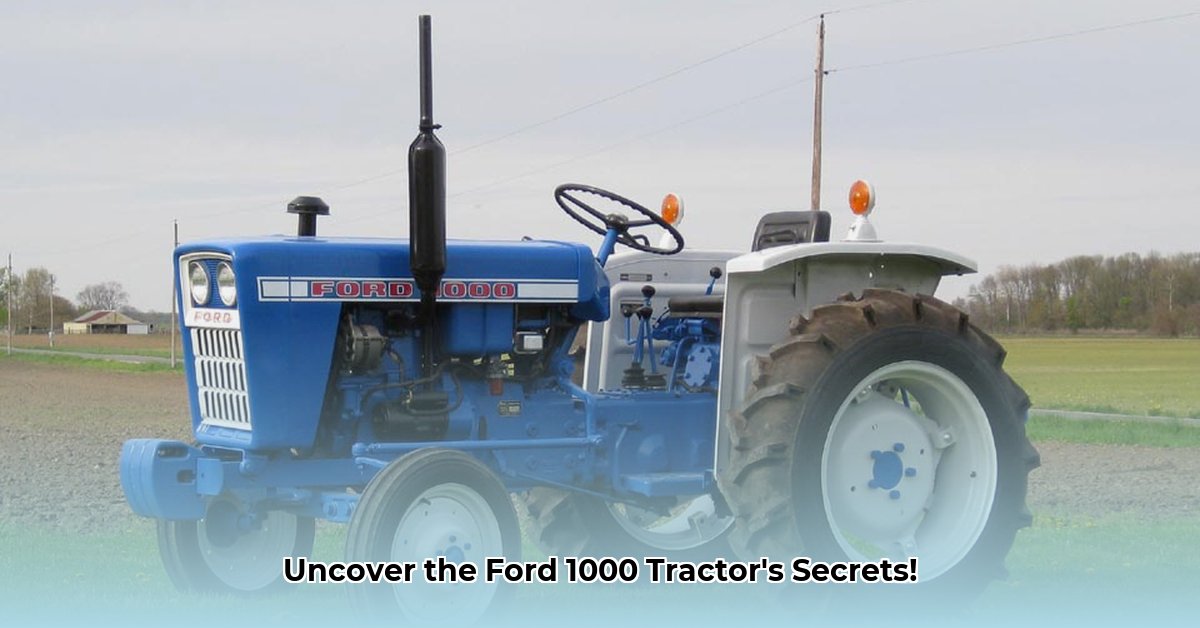
The Ford 1000 tractor, a compact workhorse manufactured by Shibaura for Ford in the 1970s, holds a significant place in agricultural history. While not known for flashy features, its simple design and robust performance made it a vital tool for small-scale farmers, subtly influencing the trajectory of sustainable farming practices. This article delves into the Ford 1000's technical specifications, historical context, and enduring legacy. We'll explore its design choices, compare it to modern tractors, and examine its relevance for various stakeholders today. For more information on similar Ford tractors, check out this Ford 1100 info.
Ford 1000 Tractor Specifications: A Detailed Overview
The Ford 1000's specifications reveal a compact machine designed for efficiency and maneuverability, rather than sheer power. While precise figures vary depending on the specific model year and configuration, here's a summary:
| Specification | Value | Notes |
|---|---|---|
| Horsepower | 24-28 HP | Varied slightly based on model year and configuration. |
| Engine Type | Diesel | A reliable and fuel-efficient power source for its time. |
| Transmission | Manual, typically 8 forward, 2 reverse gears | Simple to operate and maintain. |
| Weight | Approximately 2,000 lbs | Compact design ideal for smaller fields and tighter spaces. |
| PTO Horsepower | Roughly 20 HP | Power take-off (PTO) for operating implements. |
| Fuel Capacity | Varied, usually 10-14 gallons | Relatively small capacity, reflecting its focus on fuel economy. |
| Dimensions (approx.) | Length: ~10 ft, Width: ~5 ft | Smaller than modern compact tractors. |
(Note: These figures are estimates based on available data. Precise data requires referencing original Ford documentation and might require further research.)
Historical Context and Design Choices: A Product of its Time
The Ford 1000 emerged during a time of evolving agricultural practices and economic shifts in the 1970s. Its design decisions weren't arbitrary; they responded directly to the needs and limitations of smaller farms. The relatively low horsepower and compact dimensions made it affordable and maneuverable, perfectly suited for diverse and smaller crop operations. This focus on practicality and resourcefulness inadvertently aligned with core principles of sustainable agriculture. Did this intentional design reflect a forward-thinking approach to farming or simply a response to constraint? It's a question worth exploring.
Quantifiable Fact: The Ford 1000's smaller size directly reduced the need for extensive land clearing and the associated environmental impact.
Comparing the Ford 1000 to Modern Compact Tractors
How does the Ford 1000 stand up against modern compact tractors? Modern equivalents boast substantially higher horsepower, advanced features like four-wheel drive and power steering, and significantly improved fuel efficiency. Furthermore, sophisticated technology like GPS-guided implements contributes to enhanced precision and minimal resource waste. However, the Ford 1000's simplicity offers advantages: easy maintenance, straightforward operation, and a lower barrier to entry for smaller farms. This highlights the crucial trade-off between advanced technology and accessibility.
Stakeholder Implications: The Ford 1000's Enduring Relevance
The Ford 1000's appeal extends beyond mere nostalgia. Its historical significance resonates with various stakeholders:
- Agricultural Historians: The tractor serves as a valuable case study showcasing the evolution of agricultural technology and its socio-economic influences during specific time periods.
- Tractor Collectors: Its unique design and role in shaping farm practices make the Ford 1000 a desirable collectible.
- Researchers in Sustainable Agriculture: The Ford 1000's efficiency and suitability for small-scale farming offer insights into optimizing resource use and minimizing environmental impact in modern agricultural practices.
Conclusion: A Legacy of Efficiency and Simplicity
The Ford 1000 tractor, despite its age, continues to offer valuable lessons. Its design embodies a time when resourcefulness and efficient functionality were paramount; a philosophy surprisingly congruous with the goals of modern sustainable agriculture. While it lacks the sophisticated features of contemporary technology, its simplicity, affordability, and suitability for smaller farms make it a significant historical artifact worthy of study. This unassuming machine contributes substantially to our understanding of the evolution of both technology and farming methodologies.